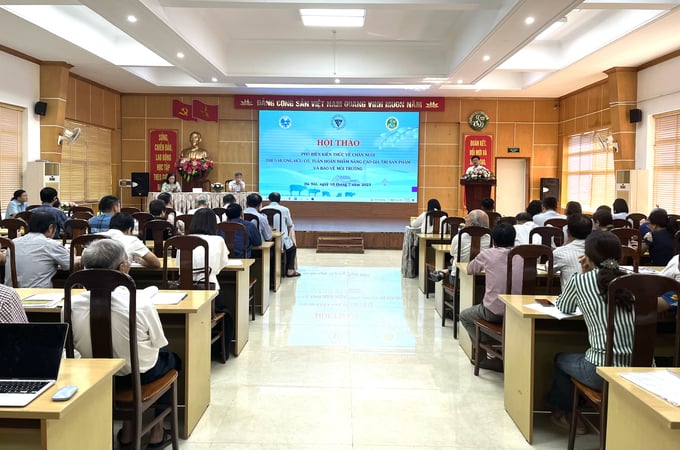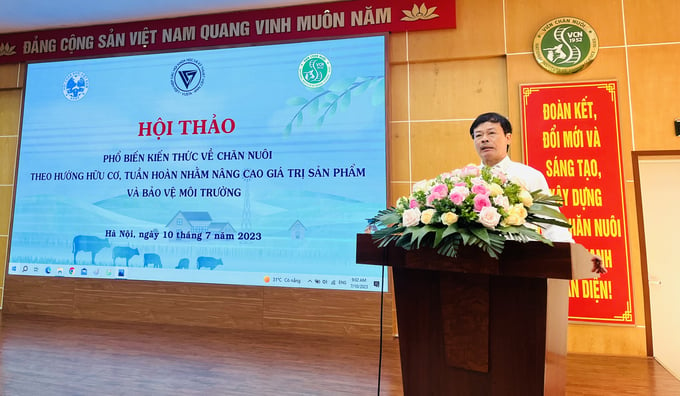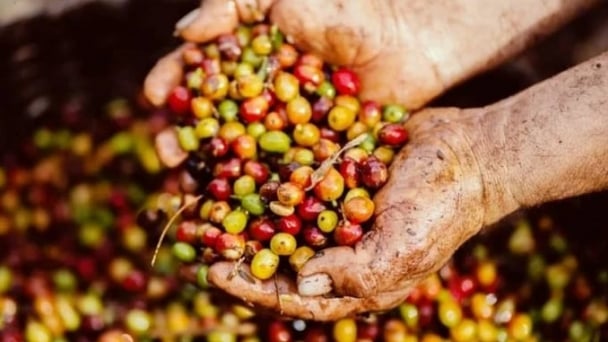June 18, 2025 | 06:44 GMT +7
June 18, 2025 | 06:44 GMT +7
Hotline: 0913.378.918
June 18, 2025 | 06:44 GMT +7
Hotline: 0913.378.918

The Seminar on “disseminating knowledge on livestock production in the organic and circular direction in order to improve product value and protect the environment” took place on July 10 at the National Institute of Animal Science. Photo: Hong Tham.
On July 10 in Hanoi, the National Institute of Animal Science in collaboration with the Animal Husbandry Association of Vietnam (AHAV) organized the Seminar on “disseminating knowledge on livestock production in the organic and circular direction in order to improve product value and protect the environment”.
According to the Department of Livestock Production, besides the achieved results, every year the livestock industry generates a large amount of waste into the environment. In the period 2018 - 2022, each year, over 60 million tons of manure and over 304 million m3 of wastewater were discharged from the main livestock species. The industry needs to find a way to treat and reuse waste to reduce greenhouse gas emissions, thus protecting the livestock environment.
Of the 60 million tons of manure produced by major livestock, 40% is from cows, 34% from pigs, 21% from buffalo and 6% from poultry. Of the 304 million m3 of wastewater, over 84% comes from pig farming. Only a part of it is treated as organic fertilizer, an input for a biogas plant system to create renewable energy, or a source of insect rearing that provides high-quality protein as animal feed and organic fertilizers. The larger part of the waste is discharged into the environment causing negative impacts on the environment.
Nguyen Xuan Duong, Chairman of the Animal Husbandry Association of Vietnam, said, “Our country's livestock industry has maintained its growth for many years, but still faces many difficulties. For sustainable development, it is impossible not to apply livestock in the circular direction”.

Nguyen Xuan Duong, Chairman of the Animal Husbandry Association of Vietnam, said that circular livestock production is an inevitable trend. Photo: Hong Tham.
Nguyen Anh Phong, Director of the Information Center for Agriculture and Rural Development (Institute of Policy and Strategy for Agriculture and Rural Development) said that in order to minimize the negative impacts of livestock production on the environment, many models developed in the direction of the circular economy have been applied, such as: Garden - pond - barn; 4F biosafety livestock (Farm - Food - Feed - Fertilizer); Green circular models; Circular beef cattle farming model.
Models applying scientific, technical, biotechnological, and physicochemical technologies to increase product value, and reduce the generation of by-products and waste include: Biogas model, the model using biological buffers in livestock production, the model of using livestock waste to raise insects such as composting worms and black soldier fly.
“The circular economy models help to make full use of agricultural by-products, minimize environmental exploitation, and make the most of natural resources. Thanks to them farmers can minimize the amount of waste and emissions released into the environment, thus making a contribution to the implementation of the Government of Vietnam’s commitment at COP26 on reducing greenhouse gas emissions with the goal of achieving net zero emissions by 2050,” said Director Phong.
According to Ha Van Thang, Chairman of the Vietnam Council of Agricultural Enterprises, agroproduction in Vietnam still mainly focuses on productivity and output, following linear thinking. The industry has not prioritized the demand for sustainable, environment-friendly development, not paying attention to the excess of the production process. As a result, the situation of wasting agricultural by-products and livestock waste is common, even causing pollution to the environment.
The development of circular livestock production is an inevitable trend. But because this is a new development model, with wide linkages, with the participation of many subjects, it requires effort and responsibility of the authorities at all levels. Chairman Thang believed that the industry needs people who are really responsible, have aspirations for the development of the locality, people who dare to think, dare to act and are “willing to eat and work together” with farmers.
“Businesses and people taking the lead in this process will face many challenges. This is the time when the support, sharing and cooperation of local authorities are needed. Only then can the goal of developing livestock in general and cattle in particular based on the circular economy be achieved," said Ha Van Thang, Chairman of the Vietnam Council of Agricultural Enterprises.
Translated by Samuel Pham
![Turning wind and rain into action: [7] Early disaster warnings help marine farmers minimize losses](https://t.ex-cdn.com/nongnghiepmoitruong.vn/608w/files/news/2025/06/17/z6704423696987_15fd32ffc26d590d204d520c9dac6786-nongnghiep-142942.jpg)
(VAN) In recent years, thanks to early disaster warnings and forecasting, marine farmers in Khanh Hoa province have been able to reduce risks and losses, thereby improving production efficiency.
![Turning wind and rain into action: [6] ‘Four on-the-spot’ disaster management software](https://t.ex-cdn.com/nongnghiepmoitruong.vn/608w/files/news/2025/06/17/e5a48259d6a262fc3bb3-nongnghiep-183800.jpg)
(VAN) By simply activating the scenario on the disaster management software, the relevant authorities immediately know how many households need to be evacuated, where to evacuate them to, and by what means of transportation…
![Turning wind and rain into action: [5] Hue applies modern technology in disaster forecasting](https://t.ex-cdn.com/nongnghiepmoitruong.vn/608w/files/news/2025/06/17/z6704423696987_15fd32ffc26d590d204d520c9dac6786-nongnghiep-093938.jpg)
(VAN) In Hue city, modern technology has recently been applied in meteorological and hydrological forecasting and warning, helping to reduce the damage caused by natural disasters.

(VAN) A cutting-edge farming technique being implemented on an experimental ranch in Arizona's Sonoran Desert has already saved a billion gallons of water over five years, according to Civil Eats.

(VAN) Poultry and pig production and the environment can be boosted through enhanced water technology, according to new research.

(VAN) Coffee prices on June 16, 2025 are unchanged. In Vietnam, local trading prices are holding steady, ranging around VND 112,000 – VND 112,500/kg.
![Turning wind and rain into action: [4] Bringing climate bulletins to remote and isolated areas](https://t.ex-cdn.com/nongnghiepmoitruong.vn/608w/files/linhnhp/2025/06/14/1152-z6704423696987_15fd32ffc26d590d204d520c9dac6786-nongnghiep-151141.jpg)
(VAN) The Vietnam Agriculture and Nature Newspaper interviewed Mr. Vu Thai Truong, Acting Head of Climate Change and Environment at UNDP Vietnam, to gain deeper insight into how climate bulletins are delivered to farmers.